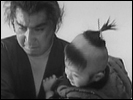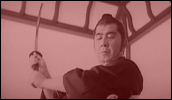Sword of Vengeance
- Year
- 1972
- Original title
- Kozure Okami Ko o Kashi Ude Kashi Tsukamatsuru
- Japanese title
- 子連れ狼 子を貸し腕貸しつかまつる
- Alternative title
- Lone Wolf and Cub: Chlld and Expertise for Rent
- Director
- Cast
- Running time
- 83 minutes
- Published
- 24 April 2001



by Jasper Sharp
Tomisaburo Wakayama is Itto Ogami, the former executioner for the shogun who is framed for treason by the scheming Yagyu clan. When his wife is murdered by the clan, Ogami is stripped of office and he and his infant son Daigoro are forced to live as outlaws. Fortunately the Lone Wolf has quite a way with sharp implements, and is able to support himself as he trundles around Edo-period Japan by working as a mercenary. Pushing his son around in a large wooden pram armed to the hilt with secret blades and with a large banner announcing "Child and Expertise for Rent" flying behind him, he waits for the day when he can avenge himself against the clan and its leader, Lord Retsudo.
"Back from the Banned!!" boldly proclaimed the cover of the first-ever British DVD release of the Lone Wolf and Cub (Kozure Okami) six-film series, by Artsmagic in 1999. Well, not exactly, as this is the first time any of these classic chanbaras have seen an airing in their original form in the UK (albeit with 6 seconds of cuts from the BBFC in this particular instance). The banned film actually referred to is Shogun Assassin, a sort of edited highlights package pieced together in 1981 by Robert Houston for Roger Corman's New World Company that used about 12 minutes of footage from this first film and the rest from its sequel, Baby Cart at the River Styx. With scant regard for the original plotting, histrionic dubbing courtesy of Lamont Johnson and Sandra Bernhard tying together the disparate gory action scenes, a continuous voice-over from the child's point of view and a chugga-chugga cod-Orientalist disco soundtrack from Mark Lindsay (former singer with Paul Revere and the Raiders), Shogun Assassin remains an undeniable guilty pleasure, and one of the more polished and entertaining films on the British "Video Nasty" list when the axe fell on the original Vipco release in the early 1980s. However, it merely acted as a taster for the original films, at last available in their full-blooded, not to mention, full widescreen glory.
The fact of the matter is that the Lone Wolf / Baby Cart series perhaps represents the very finest in the chanbara genre, beautifully photographed with a solemn, almost poetic approach to the extreme violence on display here: heads roll and geysers of blood erupt in slow motion against a golden sunset as Lord Retsudo's first son falls victim to the Lone Wolf's nemesis. Almost clinically razor sharp editing succeeded by hyper-realistic arterial spurts shot beneath the child's impassive gaze combine with moments of Zen-like stillness and stunning widescreen compositions as Ogami roams from village to village on his adventures.
As with other entries in the genre (such as Crimson Bat / Mekura no Oichi Monogatari and the Zatoichi series), the first film is more concerned with setting the back-story, introducing Itto Ogami and his antagonist Retsudo, documenting his fall from grace, the murder of his wife, and his subsequent retreat to itinerancy. As such, it is a vital part of the series, though it comes across as rather slow-moving and wordy in comparison with the continuous violent action of the second piece, Baby Cart at the River Styx, which is generally considered to be the finest of the series. However, it does still sport a ridiculously high body count among the handful of violent set-pieces, all of which (except the gruesome finale) were utilised in Shogun Assassin. Here's your chance to see them in their original context and in the original language.
Originally a long-running adult manga, the Lone Wolf series was adapted for the big screen by Shintaro Katsu, the star of Daiei studio's Zatoichi films, as a star vehicle for his brother Wakayama, who had already starred in four outings between 1968-70 in a previous chanbara series, Wicked Priest (Gokuaku Bozu). The first three and the fifth parts of the series were directed by Kenji Misumi, one of the best among Daiei's stable of chanbara directors, who had workied with Katsu on a number of the Zatoichi films. However, the original cycle of theatrical releases were not a great box-office draw upon their domestic release, and if you mention the name Kozure Okami to your average Japanese person, they'll probably have in mind the TV series made in the early 1980s starring Kinnosuke Yorozuya as Itto Ogami (and Kazutaka Nishikawa as Daigoro, who would later achieve a degree of infamy when he was arrested for the murder of the 56-year-old finance company owner, Yukio Sato). These were edited together into four feature films, the first of which is credited to Joys of Torture ero-guro auteur Teruo Ishii. The scenario was resurrected for a final theatrical release directed by Akira Inoue (Lone Wolf: Final Conflict, 1992).